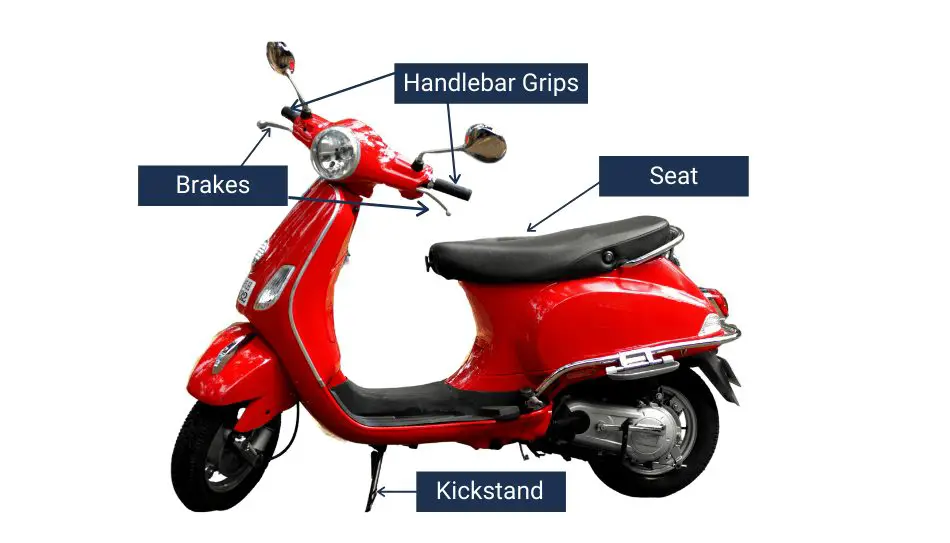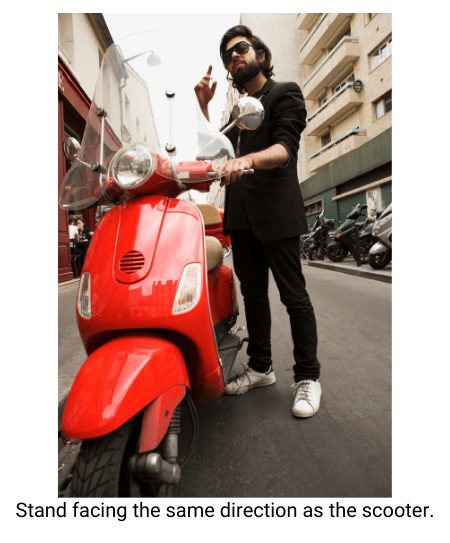If you have not ridden a scooter because you’re worried about balance, then these tips are for you! The phrase, “It’s just like riding a bike,” means that it is so easy to do even if it has been a long time. This applies to the balance required of riding a scooter! I was terrified to attend a Motorcycle Safety Foundations (MSF) basic rider course because I was scared of how to keep a scooter upright. I put it off for over a month. That’s the reason for this article. I want to walk you through what you can do at home to get some exposure balancing to help you get passed that anxiety.
To learn to balance on your scooter, you need to wear the appropriate safety gear, find a safe spot to learn, get to know your scooter, and then you’ll learn to glide. Progressing through each step and practicing will give you the skills and confidence to master balancing and move on to learning to ride.
Learning to balance will take some practice, but once you get going you will see how easy it is. I would also like to add that these steps are a progression to keep you safe. Do not move on until you feel like you have mastered the earlier steps in the process, and you’ll be on solid footing. Literally. Take this slow and steady, and practice as much as you need to feel comfortable as each new step should just feel like an accessible challenge rather than a full-on obstacle.
It is normal and ok to be scared. It is also normal and ok to be nervous. It is ok if you describe yourself as clumsy. Riding a bike does not take the level of coordination that learning to dance does thankfully, so I promise there is hope for you to safely learn to balance on a scooter and get rolling.
Do You Know How to Ride a Bicycle?
If yes, skip to the next section. If not, hang out here.
If possible, go through these steps with a bicycle first, practice full-on riding with the pedals, learn to turn, and then you can simply reiterate through these steps on the scooter. Just know that riding a bike is not a requirement in the Motorcycle Safety Foundations Basic Rider course, so do not worry if you can not ride a bike to sign up for the course. They will teach you how to balance just fine.
Safety Gear to Get Started
First, you’re going to need to be wearing protective gear. To simply balance, you do not even need the scooter to be started, but you’ll want some protection in case of a minor incident as you learn. Wear the following gear:
- Long sleeve shirt – even if it’s hot out
- Gloves – any kind
- Pants or jeans – no shorts, skirts, or dresses
- Footwear that covers your ankle – such as boots
- Helmet – DOT approved, undamaged. Borrow one if need be, but don’t practice on a scooter without one. Please, please, please!
- Scooter – or a bike if you’re learning or refreshing your memory
The good news is that by finding these items in your closet, you’ll be prepared for the MSF basic course to get your motorcycle endorsement. All of these items are required for the hands-on parts of the course.
Where to Experiment with Balancing
You will want to be on a flat surface as you start experimenting with balancing on a bike or scooter. In addition, I’d recommend you find yourself an empty driveway or parking lot with very little traffic for these exercises. When I am learning or practicing, I go to a local high school parking lot or a neighborhood dead-end cul-de-sac on a Sunday morning. It’s a solid spot for this kind of activity for me, so if you have someone that can help you get a scooter or bike to that kind of location, give one a try.
Get to Know Your Scooter
To only balance, you don’t need to know too many of the parts of your scooter, but you’ll want to know the kickstand, handlebar grips, seat, and brakes.

Incremental Steps to Balancing

To get started, stand to the left of the scooter facing the handlebar and speedometer with the scooter leaning on its’ kickstand.
Now, while standing on your left leg, swing your right leg through the step-through or over the scooter (depending on the scooter style), and plant the right foot on the ground. You should be straddling the scooter now. Woohoo!
While still straddling & the kickstand down, place your hands on the handlebar grips. Pull the scooter to the right to lift it off of the kickstand. Feel the weight when you do this.
Keeping the scooter upright (not leaning on the kickstand), have a seat with your feet still planted and hands still on the handlebar grips. Find a comfortable spot on the seat where you can still reach the grips, and you are firmly connected to the ground.
Now let’s pay attention to the brakes [image]. When you need to apply the brakes, you apply both evenly. Give them a squeeze. When you are done giving them a try, put your hands full back on the handlebar grips. NEVER hover your hands over the brakes.
While you are still seated, walk the scooter forwards and backward. Scooters tend to be a bit heavier but check out this YouTube video of a cute kiddo scooting around on a balance bike to get an idea of what you are trying to accomplish. It’s called gliding when you can get going pretty good, but it’s more of a power walk when you are trying to move a heavy scooter. Think of it as if you are on a Flintstone-style motorcycle, and have some fun with it. Apply the brakes (both hands evenly) and see how that feels.
Now see if you can ‘glide’ with both feet off the ground for 3 seconds or so. This is balancing! Notice we haven’t even started the scooter yet!
Now what?
Now that you have learned to balance you are ready to full-on learn to ride a scooter. If you were just hoping to get a little knowledge to feel better about learning at all, that’s really all there is to it. Practice a bit, and then it’s time to turn the scooter on and ride!
If you are worried about what it looks like to start it and add speed, please know that speed equals stability. It is easier to balance as you gain speed. You will slowly give the scooter some gas by gently easing you’re the throttle towards you, and if you’re slow enough, you can use your feet to feel that kind of glide. Eventually, you’re giving the scooter gas, and pretty much immediately pulling your feet up to their positions on the scooter. Don’t be afraid of what’s next. It’s a progression!
I promise that if you learn to balance at the slow speed that you’ll be golden when it is time to kick the throttle up a notch to accelerate on the road.
Wrap It Up
I hope that you can walk away from this article with enough knowledge to feel a little more confident learning to ride a scooter. Riding is fun, and while some people are eager to get on the road as fast as possible, it is safer to spend time mastering the basics to make you a more experienced, knowledgeable scooterist. I highly encourage you to find a Motorcycle Safety Foundation course before you hit the road. They will teach the techniques from the ground up very thoroughly. You will also get some time on the seat to practice, and you could end up with an insurance discount for your effort, as well!
